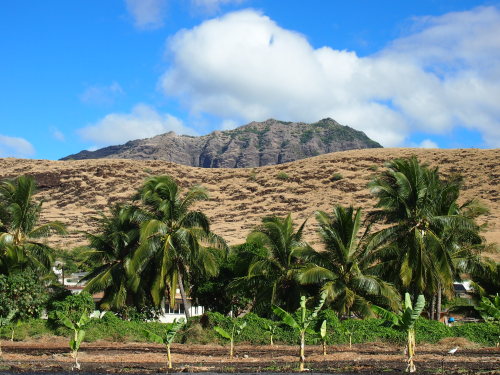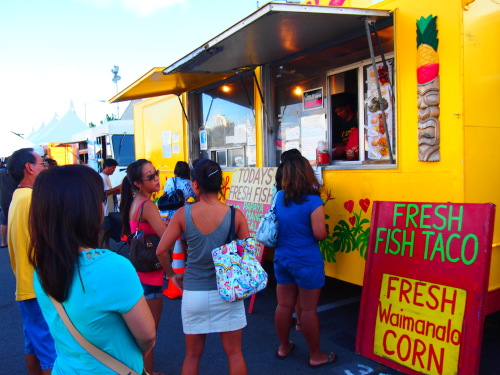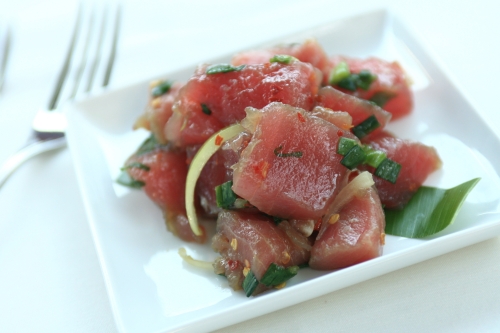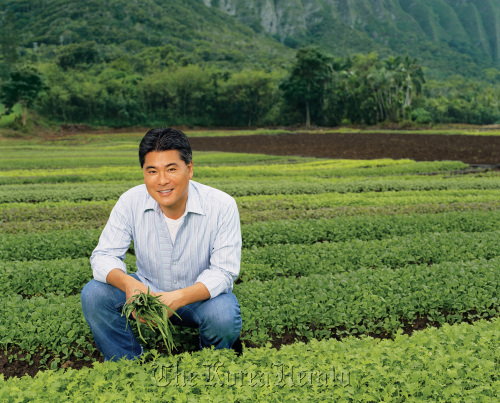
Oahu’s fresh farm-to-table cuisine captivates international gourmands
OAHU, Hawaii ― When Manny Miles, 27, looks out from his farm field across the majestic Waianae Valley in Oahu, he sees a bright future for the food industry in Hawaii.
Hawaii is a tourist paradise and has a long history as a favorite destination for honeymooners, but the tropical islands are now trying to receive high marks for its culinary scene.
And young farmers like Miles have been at the heart of the farm-to-table movement, making healthy, locally grown food accessible to everyone on the islands.
“Most of our food is from the West Coast of the United States or from Mexico. And we even get fruits and vegetables from China and Japan, because they are cheap,” Miles admitted.
There is a shift, however, in Hawaii with more people here wanting locally produced foods, he added.
Miles for the past 10 years has been working on the Mao Organic Farms, a 20,000-square meter farm, established by Waianae Re-Development Corp.
“When I first started working here, no one really knew we also grow organic vegetables here, but now people here want to eat good food.”
Many global travelers love visiting Oahu for its unmatched weather, beautiful beaches and unique culture, but these days Oahu’s innovative farm-to-table cuisine is one of the island’s main attractions.
Fresh produce
As they say here, the cuisine on the island is more than just something to taste, it’s something to be experienced.
And visiting Farmer’s Markets would be a good way to set off for a culinary adventure in Oahu. The island’s many farmers’ markets provide fresh, locally grown produce.
The most notable is Saturday’s Farmer’s market, which is open each Saturday morning from 7:30 a.m. to 11 a.m. on the campus of Kapiolani Community College at Diamond Head.
When our group went there on Oct.1, though it was only 8 a.m., the place was already packed with people standing in long lines waiting to get freshly baked bread, tropical jams and honey and a wide variety of fruits.
From there, one can also get unique snack foods and specialty seasoning from nearly 30 vendors that provide specialty food items that are not available at stores.
Shoppers can also visit the Farmer’s Market at Royal Hawaiian Center, which opens from 4 p.m. to 7.30 p.m. every Tuesday, in the heart of Waikiki.
The Hawaii Farm Bureau Federation also hosts its own Farmer’s Market at the Neal S. Blaisdell Center from 4 p.m. to 7 p.m. every Wednesday.

Food truck rally
For a long time, Oahu’s lunch wagons have fed hungry surfers and industrial workers on their lunch breaks. But the four-wheeled eateries have now also become popular among travelers who seek cheap and quick bites.
If you want to get a taste of most popular food trucks and street vendors in Hawaii, visit the Eat the Street Festival in the Kakaako neighborhood in Honolulu.
The festival, held every last Friday of the month from 4 p.m. to 9 p.m., features a diverse range of food vendors, serving everything from mouth-watering pork adobo omelets to hand-rolled and baked cupcakes to Hawaii-produced ice cream.
The organizer said it features more than 30 of the best food trucks in Hawaii, attracting an average of 6,000 people monthly.
Everything tried here was unique, but a tasting sampler of Ono Pops’ half juice-based and half-milk based ice cream, such as a strawberry-Maui-goat-cheese and a chocolate-apple-banana, was extra special.
From plate lunch to ahi poke
Oahu is also known for its diverse culture as many different ethnic groups make up the island. And it is exhibited in its diverse foods.
Plate lunch has been popular in Hawaii since the late ‘20s, when sugar companies established plantations here, attracting laborers from across the globe.
“It’s a combination of the Japanese bento and plantation workers taking their lunches in tin boxes,” said local food columnist Catherine Toth, who guided us around to get a taste of the local cuisine.
With a five-minute wait and about $5, one can buy various entrees from beef teriyaki to roast pork, served with two scoops of rice and one scoop of macaroni salad. Rainbow Drive-in (www.rainbowdrivein.com) has been a local favorite for more that 50 years. Its signature menu includes teriyaki beef, chicken and mahi mahi ―dolphinfish also known as lampuki― all smothered in brown gravy.
Helena’s Hawaiian Food (www.helenashawaianfood.com), a family-owned small restaurant, is also well known among the locals. Portions are big and include menu items kalua pig, short ribs and lomilomi salmon.

If you are here, don’t leave without trying traditional Hawaiian poke, a cubed raw fish salad marinated in sea salt and sesame oil. Alicia’s Market, a small family-store that opened its door in 1943, offers popular poke dishes, such as wasabi masago (capelin roe) poke and ahi (tuna) poke, at Kalihi Kai store in Honolulu.
Fine dining
Oahu also offers fine dining restaurants and some local chefs have developed a distinctive cuisine using a fusion of culinary and ethnic food styles found in the islands.
Alan Wong’s Restaurant (www.alanwongs.com) in Honolulu is known for fun flavors to savor, such as crispy wonton ahi poke balls on avocado and macadamia nut-coconut crusted lamb chops.

Roy’s Restaurant offers Chef Roy Yamaguchi’s signature Hawaiian cuisine, which includes roasted macadamia nut mahi mahi with lobster butter sauce, at its three Oahu locations in Hawaii Kai, Waikiki and Ko Olina.
George Marvrothalassitis’ Chef Mavro Restaurant (www.chefmavro,com) menu features Hawaiian cuisine influenced by his native province of France with select wines that best complement each dish.
Yamaguchi and Wang, two of Hawaii’s most-well known chefs, co-hosted the inaugural Hawaii Food & Wine Festival on Sept. 29-Oct. 1, inviting master chefs from across the globe, including Edward Kwon from Korea, to showcase innovative dishes inspired by the diverse cuisine of Hawaii.
“We’ve got great feedback this year, everybody loved the idea, chefs from all different areas in the world all cooking with local products,” Yamaguchi told The Korea Herald, saying he would continue to hold the event to support the growing of local ingredients in Hawaii again next year.
“It’s still cheaper to bring stuff from the mainland, because the land is so expensive in Hawaii. But for us to be able to grow and buy from local areas is important as we want give our guests as more fresh ingredients as possible,” he added.
To get there:
Hawaiian Airlines recently launched non-stop flights between Incheon and Honolulu four days a week (Mon, Wed, Fri and Sun). Also, Korean Air currently operates direct flights twice a day, and Asiana Airlines two days a week (Thu, Sun).
By Oh Kyu-wook, Korea Herald correspondent
(596story@heraldcorp.com)
-
Articles by Korea Herald








![[Graphic News] More Koreans say they plan long-distance trips this year](http://res.heraldm.com/phpwas/restmb_idxmake.php?idx=644&simg=/content/image/2024/04/17/20240417050828_0.gif&u=)
![[KH Explains] Hyundai's full hybrid edge to pay off amid slow transition to pure EVs](http://res.heraldm.com/phpwas/restmb_idxmake.php?idx=644&simg=/content/image/2024/04/18/20240418050645_0.jpg&u=20240419100350)






![[From the Scene] Monks, Buddhists hail return of remains of Buddhas](http://res.heraldm.com/phpwas/restmb_idxmake.php?idx=652&simg=/content/image/2024/04/19/20240419050617_0.jpg&u=20240419175937)

![[KH Explains] Hyundai's full hybrid edge to pay off amid slow transition to pure EVs](http://res.heraldm.com/phpwas/restmb_idxmake.php?idx=652&simg=/content/image/2024/04/18/20240418050645_0.jpg&u=20240419100350)

![[Today’s K-pop] Illit drops debut single remix](http://res.heraldm.com/phpwas/restmb_idxmake.php?idx=642&simg=/content/image/2024/04/19/20240419050612_0.jpg&u=)